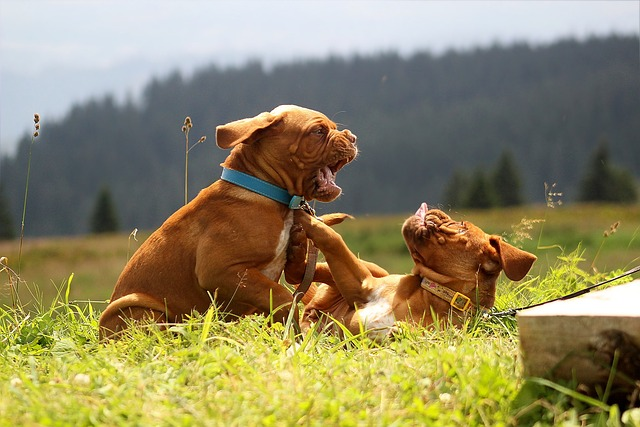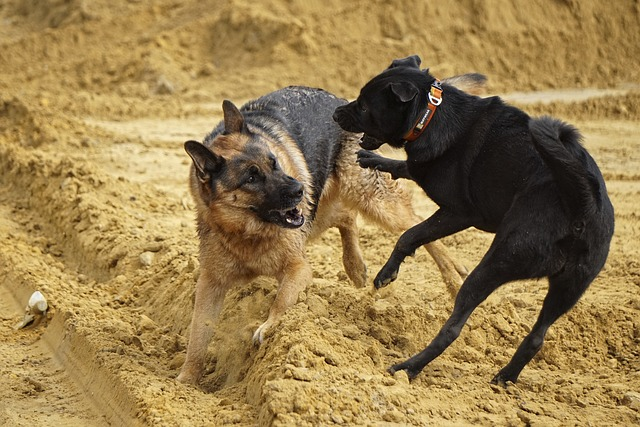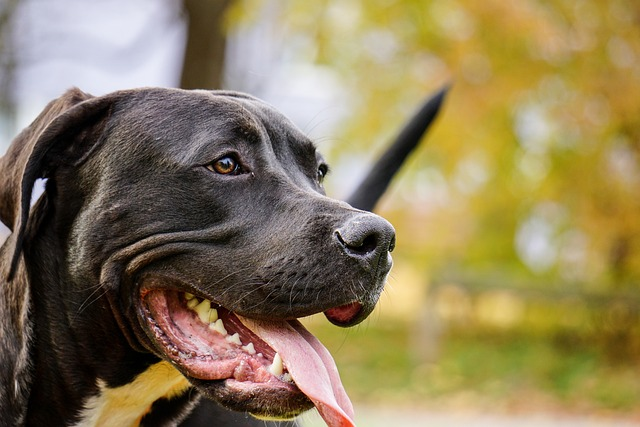How to discipline a dog after fighting - 3 things to AVOID

The information below is solely for educational purposes.
If you've ever encountered a dog fight you know how dangerous these can be.
Dog bites can go up to 700 PSI (Kangal Shepherds) and can be strong enough to break a human's arm!
Add to this a set of razor-sharp set of teeth and an unflinching mentality toward their opponent, dog fights can be a scary situation to deal with and can cause serious injuries and even death if not broken up.
Understanding why your dog has gotten in a fight is the first step to understanding how to discipline it afterwards.
Let's get started!
Why do dogs fight & how can you discipline them afterwards correctly?

Understanding WHY a dog has got into a fight is the first step in understanding how to discipline it correctly.
Without identifying the reason behind the fight if you discipline a dog in the same way regardless of the reason the fight was started it can cause serious issues if applied incorrectly.
Dogs tend to get into fights for a variety of reasons but most stem from some form of aggression related behavior.
It can be challenging to identify if they are being aggressive due to being fearful or if they are actually dog aggressive (which is luckily rarer in most cases).
If your dog has started to get into regular fights then it is always recommended to seek professional help from someone who is an expert in canine behavior so they can correctly diagnose the cause of your dog's behavior.
Saying that below are the top 5 reasons which can cause dogs to get in fights and then some relevant tips on how to discipline a dog after fighting.
1. Sex-related aggression
This one is super common!
I experienced this myself with my intact male Doberman when he became an adolescent. We would be walking in the park and if another dog came near of a similar size and females were nearby my dog would start to get aggressive towards them and sometimes try to fight them.
When he was younger he had zero fights (apart from the odd Dashund or Chihuahua that went for him on walks but that was them picking on him!).
As he hit his teenage phase and reached sexual maturity he did start to display some aggressive tendencies towards other intact male dogs when other females were around and also received aggression from other intact male dogs.
The reason this dog behavior happens is basically when intact males want the attention of females they can sometimes fight each other to show they are the pack leader and have the mating rights.
How can i discipline my dog in this situation?
If it's your dog that has initiated the fight with another dog then physical corrections like a lead pull or if using a prong collar a correction wont work to snap your dog out of their mindset.
In fact it can actually rile them up even more than if you didn't correct them.
In this case one of the most effective ways to discipline your dog is to use a training collar with remote vibrate functionality. The best brand of these is Dogtra (i use one myself) which you can find on Chewy.com.
When your dog starts to get aggressive you turn on the vibrate which will snap them out of their fixation. As soon as they calm down you reward with a treat. Your dog will learn the desired behaviour after multiple repetitions.
You can see a more detailed video of this here:
2. Territorial/Protection Aggression
Some dogs will show aggression toward intruders on their properties which can result in serious fights.
For certain breeds this is desirable, however, this can become a serious issue if dogs direct this in the wrong situations i.e. towards the mailman.
Protective aggression is when a dog shows aggression to a person or dog that they deem a threat to them or their loved ones.
Similar to territorial aggression this can be the desired response however problems arise when dogs misread the situation and it is a common cause of attacks on small children.
How can i discipline my dog in this situation?
If this behaviour is desirable then you want to avoid discipline your dog at all otherwise they will stop being as protective.
Obedience training can help to control the situation so that this behavior only appears when necessary and you can make the dog stop on command.
If however, you don't want this behaviour then here is a video on how to train your dog:
3. Resource Guarding
Resource guarding is when a dog becomes aggressive around something it deems as a high-value resource. This can be its food, toys, bed, or even its owner!
Resource guarding is one of the most common reasons that two dogs that live together can get in fights as many dogs want to guard their possessions against others.
Dog behaviorists think this stems from their ancestral requirement to protect their food or territory from other packs or predators.
This often has many warning signs before evolving into a fight. Some warning signs are growling, stiff body language, and nips.
It is easy to diagnose this behavior as every time you or your other dog goes near its food, toys or bed and it triggers a reaction then you have a resource guarding problem.
How can i discipline my dog in this situation?
Essentially you need to stop the behaviour before it develops into a fight. For example if you have food on the floor and you can see one of your dogs is starting to get stiff or have a low growl then this behavior needs to be punished.
You will want to set up some sort of protective barrier between the 2 dogs and place some food down so that it cant actually turn into a fight.
The second you see the dog reacting in a negative way (stiff body, growling etc.) then shout 'LEAVE IT!' or clap loudly and walk towards the dog.
This shows you are the boss of the household and that the behavior will not be tolerated. Again, with any training this needs to be completed with repetition.
For a detailed video on how to do this from one of my favourite trainers see below:
4. Dominance or social aggression
This is where one dog thinks of itself as higher status than other dogs and wants to instill this social status via fighting.
Dogs interact differently from humans and are pack animals. They can sometimes engage in fighting to show that they are at the top of the pack.
Sometimes this happens more when they or the other dog is on the lead. Identifying the trigger that sets your dog of is critical.
How can i discipline my dog in this situation?
You need to be very clear with your communication with your dog in this situation so they understand that if they behave in a certain way then there will be consequences.
Firstly don't say 'No!' unless your dog understands that it has a negative consequences. Without "No!" having a meaning you are just giving your dog attention which equals reinforcement.
Here's a detailed video on good ways to handle this situation:
5. Predatory Aggression
Predatory aggression is rare and usually involves a dog showing its natural canine instincts. It usually occurs towards small animals like birds or squirrels.
Luckily it is quite uncommon to be displayed towards other dogs or people however it can occur towards children if the dog mistakes it for prey. It's usually triggered by fast movement and triggers the dog's natural instincts to chase, catch, and sometimes kill.
How can i discipline my dog in this situation?
This one is all preventative. As soon as your dog shows signs of growling, intense staring at the sign of a small animal like a cat you need to give it a quick lead pop.
Here's a great video on leash correction:
What you should NEVER do after a dog fight (3 tips on what to avoid)

Knowing how to discipline your dog is one thing but sometimes this isn't the correct response depending on the situation. If you discipline your dog at the wrong time then it can lead for your dog to turn on you or lose trust in you as the pack leader.
Remember there is no such thing as bad dogs. They just haven't been taught how to act correctly in certain situations by their owners.
Let's dive in...
If a dog is aggressive.
If dogs are actually aggressive (we recommend speaking to an experienced professional as this is quite rare compared to a fear response) then physically correcting it can cause the dog to redirect its aggression toward you which can lead to serious injuries.
Instead remain calm and address this problem with professional help instead of the heat of the moment.
If a dog is fearful.
If your dog has got in a fight because of being fearful then giving them physical punishment will destroy the bond between you very quickly and is not the right way to discipline them.
Instead, this requires dog training with a professional to teach them not to be scared and to look to you for guidance in certain situations.
If a dog has been attacked by another dog.
Never discipline dogs that think they are in immediate danger. For example, if they have been attacked by another dog and then react, disciplining them for doing absolutely nothing wrong can damage your relationship.
If you punish them it can actually cause them to become more reactive as your dog will now not think you will advocate it in any similar situations in the future.
Wrapping up

In conclusion, disciplining a dog after a fight requires a careful approach that takes into account the dog's temperament, the underlying cause of the aggression, and the owner's own behavior.
By using positive reinforcement, well timed corrections, consistency, and clear communication, you can effectively teach your dog to behave appropriately and prevent future fights.
Remember to seek professional help if needed, and above all, prioritize the safety and well-being of both your dog and those around them if you feel you cant manage it yourself.

